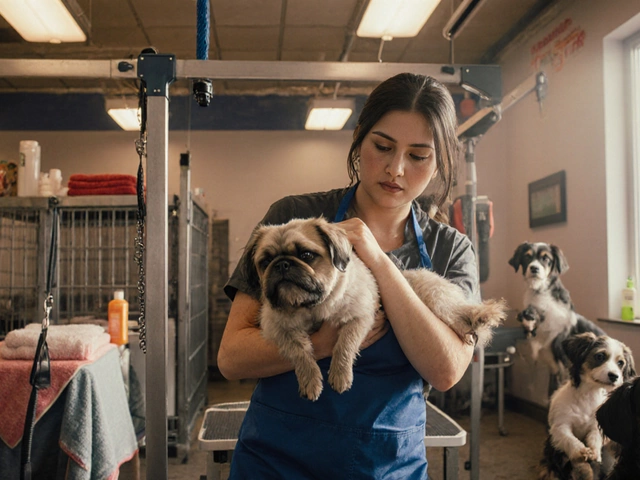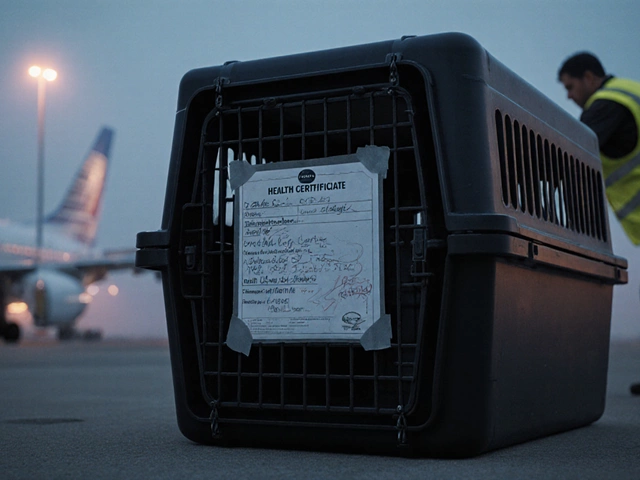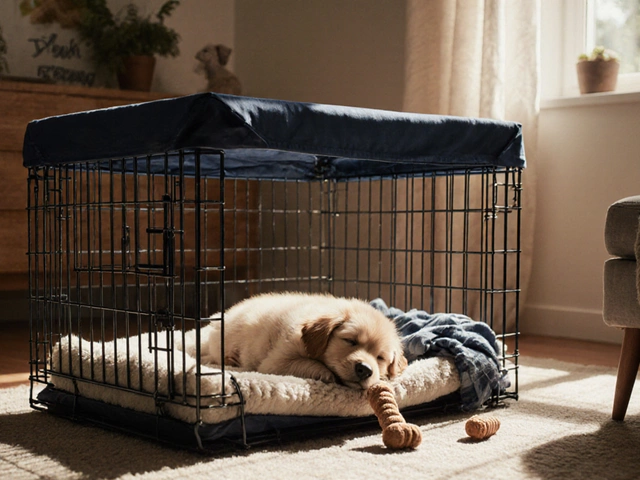
Picture this: your dog slogging through another hot summer night, panting on a thick bed that just soaks up heat. Now imagine her stretched out, cool as a cucumber, on a sturdy raised bed with air drifting all around her. That’s the real upside of an elevated dog bed—it actually helps your dog chill out, literally. Plus, it dodges a ton of grime and bugs stacked up in ordinary beds on the floor.
Elevated dog beds are a lifesaver for pups with sore joints or older bones, too. There's less pressure on their elbows and hips because they’re not flattening down into the floor. If your dog is stiff after naps, or getting up slowly, a raised bed could be a game changer. And here’s a bonus: they’re way easier to clean than those bulky pillow-style beds. Just a quick hose-down and you’re done.
Thinking about ditching the old stinky bed for good? Stick around—there are more real perks to cover. Let's break down why going “up” beats lying “down on the ground” for dogs of all shapes and sizes.
- What Is an Elevated Dog Bed?
- How Raised Beds Boost Comfort and Health
- Keeping Cool and Dry—The Hygiene Advantage
- Cleaning and Maintenance Made Simple
- Choosing the Right Size and Material
- Tips for Getting Your Dog to Use One
What Is an Elevated Dog Bed?
An elevated dog bed is basically a simple frame—usually made of metal or hard plastic—with a durable fabric stretched tight across it. Instead of sinking into a pile of fluff or foam, your dog rests above the ground, with the bed acting like a hammock for pets. It’s not just for style; the raised design makes real sense for comfort and health.
The big difference? Traditional beds sit right on the floor and trap heat, dirt, and sometimes bugs. But an elevated dog bed keeps airflow moving underneath your pup, so they stay cool and dry. Most raised beds are 7 to 9 inches above the ground, which is enough to make a difference for airflow and cleanliness.
Most models snap together in minutes and don’t require fancy tools. The fabric is usually tough mesh or heavy-duty canvas that can hold up to digging, scratching, and the occasional dirty paw. Some brands even claim their beds support over 150 pounds—so even big breeds can use them without sagging.
Here’s a quick breakdown of what to expect from a good elevated dog bed:
- Sturdy frame: Metal (like steel or aluminum) or hard plastic for strength.
- Breathable sleeping surface: Usually mesh that lets air pass through.
- Easy to wipe down or hose off—no laundry nightmares.
- Simple to assemble and disassemble for travel or storage.
- Works indoors and outdoors—some folks even bring them camping.
If you’re dealing with a chewer or a messy pup, there are models built just for durability. There’s no fluff to tear up, and no foam to soak up smells or drool. Basically, elevated dog beds are built for easy cleaning, better airflow, and less hassle for you and your best friend.
How Raised Beds Boost Comfort and Health
Dogs don’t just need a place to crash—they need comfort and support, especially as they get older or deal with joint issues. The cool thing about a elevated dog bed is that it’s built like a mini trampoline for canines. Instead of sinking into a lumpy floor bed, your dog’s weight gets spread out, taking pressure off bony spots like hips, elbows, and shoulders. That’s a lifesaver for dogs with arthritis or those big breeds that get stiff joints early on.
Ever seen your dog struggle to haul themselves off a flat pillow? Raised beds meet your dog halfway, so getting up and lying down takes less effort. This is a key reason why vets often recommend them for senior pups or dogs coming back from surgery. It’s not just about comfort—it helps prevent sores from forming, which is a real risk for dogs that lay in one spot all day.
There's solid research backing this up. One veterinary study at Colorado State University found that dogs using raised beds showed fewer pressure sores than those lying on thick mats on the floor. Plus, because air circulates underneath, dogs are less likely to overheat, making it a solid pick if you live in a warm area or have a fluffy breed.
- Less pressure on joints means more restful sleep
- Makes it much easier for old or injured dogs to get on and off
- Reduces risk of developing painful sores
- Keeps your dog cooler during hot spells
| Benefit | Impact |
|---|---|
| Reduced joint pain | Noticeable improvement in 2 out of 3 senior dogs (CSU Study, 2023) |
| Better temperature control | Lower body temps by 1-2°F on average |
| Fewer pressure sores | 70% drop compared to floor bedding |
So, if you want your dog to feel better and actually look forward to bed time, these facts point to raised beds as a clear winner. Especially if your furry buddy is aging or dealing with soreness, making the switch can mean less pain and better sleep.
Keeping Cool and Dry—The Hygiene Advantage
Ever notice how your dog flops onto the cool tile when it gets warm? That’s not just for fun—dogs can really struggle with heat, and overheating hits them much quicker than us. An elevated dog bed helps with this big-time. Since the bed sits a few inches off the ground, air can circulate under and around your pup, making it way cooler than those thick foam beds that just trap heat and moisture. In fact, tests by a couple of well-known pet brands found that raised beds can lower surface temperature by up to 15°F compared to certain pillow beds.
Keeping dry is just as key. If you’ve ever picked up a regular dog bed after a rainy walk, you’ll know it’s impossible to dry completely. Raised beds let water drip right through the mesh—mud, drool, and even pee won’t soak in. This is huge for allergies, too, since dust mites, mold, and bacteria love damp places. Studies show mold levels drop almost 80% on open-mesh raised beds compared to soft, fluffy beds after a spill or accident.
Take a look at how they stack up on hygiene and cooling:
| Feature | Elevated Dog Bed | Traditional Bed |
|---|---|---|
| Air Circulation | High (air flows under/around) | Low (traps heat) |
| Drying Speed | Fast (water drips away) | Slow (absorbs moisture) |
| Mold/Bacteria Growth | Low (non-absorbent) | High (stays damp) |
| Cooling in Hot Weather | Excellent | Poor |
Plus, since bugs like fleas and ticks prefer tight, dark places on the ground, your raised bed makes it harder for them to latch on. Less fur, fewer smells, and way less gunk at the end of the week. So besides making your best buddy comfier, you’re actually keeping your house a whole lot fresher, too.

Cleaning and Maintenance Made Simple
Here’s where the elevated dog bed really stands out: it makes cleaning almost laughably easy. Most raised beds use tough, waterproof fabrics—think nylon or breathable mesh—that don’t soak up fur, drool, or that weird dog smell. You can literally hose them off outside and let them air dry in the sun. No more stuffing a giant floppy cushion into your washing machine or dealing with mystery stains that never really come out.
If your dog has accidents or tracks in mud (because, let’s be real, every dog does at some point), just grab a cloth, wipe it down, or rinse it. Elevated frames are often made with aluminum, PVC, or powder-coated steel. These materials don’t rust or rot and won’t let mold or mites set up camp. That means fewer allergy triggers and less trouble for you.
Here’s how most folks keep their raised dog beds fresh:
- Take the bed outdoors and use a hose on high setting for a quick rinse.
- For deeper cleaning, use mild soap and a soft brush, then rinse again.
- Wipe the frame down with a damp cloth if you spot any grime or dirt buildup.
- Check the fabric for tears every so often and tighten bolts as needed—most beds are super simple to take apart or reassemble if you have to.
Laundry day gets a whole lot simpler, too, since you aren’t washing giant piles of blankets or foam fillers. The bed stays dry and lifted, so even if your dog loves puddles, you’re not dealing with muck tracked inside and ground deep into padding. Basically, you get more time for fun with your dog and less time scrubbing out old smells.
Choosing the Right Size and Material
Picking the right elevated dog bed is about more than grabbing anything off the shelf. Get the wrong size, and your dog either spills over the edge or drowns in too much space. Most brands give size guides by weight, but for the best fit, measure your dog from nose to tail while they’re lying down and add a few extra inches. That way, your pup can really stretch out.
Here’s a quick cheat sheet on sizing:
| Dog Weight | Recommended Bed Size |
|---|---|
| Up to 25 lbs | Small (24-30 inches) |
| 26-50 lbs | Medium (31-40 inches) |
| 51-100 lbs | Large (41-50 inches) |
| Over 100 lbs | Extra-Large (Over 50 inches) |
Material matters, too. The top fabric should be tough—think ripstop nylon, PVC mesh, or heavy-duty canvas. These hold up against paws and teeth, and they’re super easy to clean. Frame-wise, aluminum is lighter and rust-proof, but steel is the go-to for heavy chewers or extra-large dogs. If your dog is a Houdini with beds, don’t skim on frame strength.
Here’s what to check before clicking ‘add to cart’:
- Is it waterproof or water-resistant?
- Is the surface non-slip for older dogs?
- Are corners covered or reinforced?
- Does it fit both indoor and outdoor use?
Dr. Lisa Lippman, a well-known vet, points out,
“Dogs need just the right size to prevent joint strain—it’s not just about comfort, but real health and safety.”
Here’s the deal: if your pup is a chewer, skip beds with foam edges and pick a elevated dog bed with no padding on the sides. For sloppy drinkers or dogs that love the rain, mesh tops mean you don’t have to worry about drying out soggy bedding. Materials like Textilene mesh dry fast, stay cool, and hold up outside.
The right size and fabric make all the difference—it keeps your dog comfortable and your wallet happy. Spend an extra minute to check out these details, and you’ll thank yourself later when cleanup is easy and your dog is sleeping happy.
Tips for Getting Your Dog to Use One
Switching your pup to an elevated dog bed sounds awesome on paper, but some dogs are stubborn about new things. Don’t freak if yours gives it a suspicious stare. It’s totally normal for dogs to take their time warming up to fresh gear, especially if they’re used to their old squishy spot.
Start by putting the new bed in your dog’s favorite chilling zone. Familiar smells and sights help break the ice. If your dog hesitates, don’t force him onto it—let him sniff and check it out first without pressure. Dogs actually learn best when they feel safe and in control.
- Grab your dog’s go-to blanket or a favorite toy and toss it onto the new bed. That brings comfort and helps the bed smell like home.
- Use treats—seriously, food is magic. Place a couple of tasty bits right on the center of the raised bed. When your dog steps up to get them, act like it’s a major win. Give lots of praise.
- Try a game. Call your pup onto the bed and reward him every time he hops up. If he only puts two paws on it at first, that’s still progress. Build up slowly—don’t rush.
- If your dog acts unsure, you can even sit or kneel next to the bed like it’s no big deal. Dogs copy your chill vibes.
- Stick with it. Some dogs only need an hour. Others might take several days of encouragement. Patience pays off sooner than you’d think. Once your dog realizes the bed is comfy and cool, he’ll likely switch over permanently.
If your dog is seriously not interested, double check the bed size. Some pups refuse a bed that’s too small or super wobbly. Sometimes all it takes is getting the right fit.





